Uncalibrated
Results
Brightness and Contrast Ratio
For the brightness, contrast, and color accuracy tests, we depend on the hardware colorimeter and software to help calibrate the displays. As previously stated, we use a Monaco Optix XR (DTP-94) colorimeter and Monaco Optix XR Pro software. The software and hardware help users to get color that is more accurate from their displays. Before we get to the calibrated results, we took a quick look at the range of brightness and contrast at stock settings while changing just the brightness level.
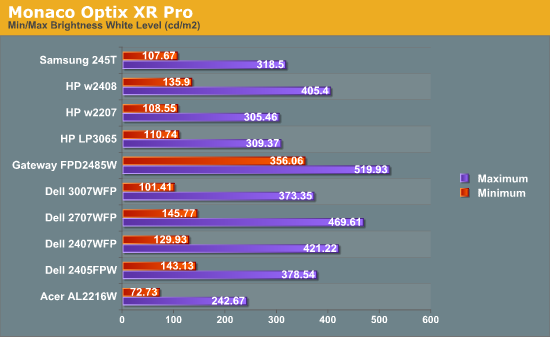
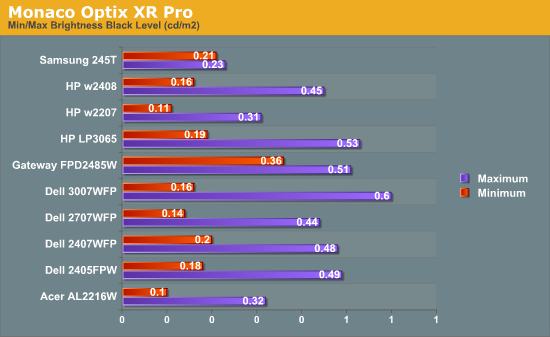
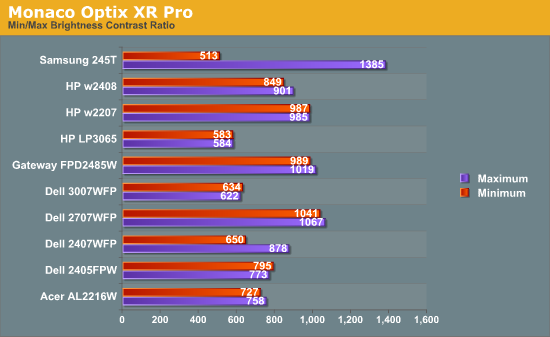
Without adjusting any of the default settings other than brightness, the maximum brightness level of the Samsung 245T reaches almost 320 nits -- as usual, more than most people need. At minimum brightness, we measure just over 100 nits. Further tuning of the color levels allows us to reach slightly lower/higher brightness levels, but the default range is sufficient. At maximum brightness, we measure a contrast ratio of nearly 1400:1 -- even without the dynamic contrast setting enabled. Reducing the brightness also reduces the contrast ratio, and it's interesting to note that black levels are reasonably stable at around 0.22 nits.
What happens when we enable Dynamic CR? Maximum brightness jumps to 350 nits while the black level went up slightly to 0.24 nits, resulting in a final contrast ratio of 1460:1. That's pretty close to the advertised 1500:1 contrast ratio, but the impact on Delta E is quite severe. Even after calibration -- which appears to get confused by Dynamic CR -- we measured an average Delta E of 7.029. That's worse than the uncalibrated Delta E we'll see below, so we recommend turning off the dynamic contrast.
Color Accuracy
The problem with calibrating a display is that it doesn't help all applications. Specifically, the video overlay used when watching DVDs or other movies completely bypasses any color profiles, so you are stuck with the uncalibrated colors. Playing games also uses the default color options. It is possible to tweak things using the OSD, but the amount of color correction that can be done via the OSD pales in comparison to color correction tables. Ideally, we would like to see video drivers begin to apply color profiles to all output -- office applications, movies, games, or anything else.
For uncalibrated color accuracy, we adjust the brightness as well as the contrast and colors (where applicable) using a "calibrate by eye" chart and the OSD controls. Also remember that color accuracy can vary from panel to panel even within the same model, and the results we are reporting are only from testing a single LCD. During testing, Monaco Optix XR Pro sends 24 color patches to the display with the colorimeter measuring the resulting values. The difference between what the requested and actual colors shown on the LCD is Delta E, with lower values being better. Any score less than one is "perfect" -- the naked eye is not going to be able to tell the difference -- and scores less than 2.0 are nearly perfect.
Ideally, you would want all of the tested colors to have a Delta E of less than 1.0, but almost no one is likely to have problems with anything scoring below 2.0. From 2.0 to 4.0, most people still won't notice the slight inaccuracies in the color palette, but when comparing displays side-by-side, differences may be apparent -- multimedia professionals in particular would prefer better colors. Anything above 4.0 begins to represent a more significant deviance, and numerous scores above 6.0 will almost certainly be noticeable by anyone using the display. Consistency is also important, so a display that has very good scores overall but with high spikes on some colors may actually be less desirable than a display with a slightly higher but more consistent average Delta E. Note also that fluctuations of as much as one point in Delta E are possible during a short amount of time. It generally takes 30 minutes for a display to warm up, and we perform all of our calibration and testing after the displays have been running for at least one hour with the screensaver disabled.
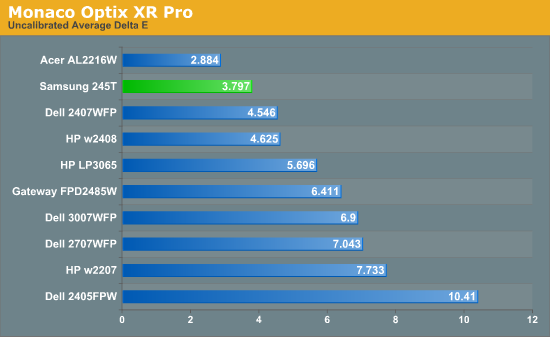
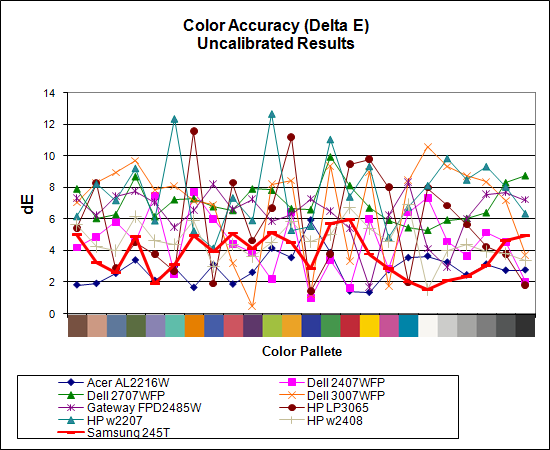
Without any form of color correction, the Samsung 245T rates a very good -- especially relative to the competition -- 3.80, ranking second overall with a relatively large gap between it and the nearest competitors. The Acer still scored better, but with that display had other concerns. The individual color scores are also very good, with the worst still only 6.0 and many others are below 3.0. So far, this is the best overall display when it comes to color accuracy -- provided of course that you stay away from the Dynamic CR setting. It's not perfect, but after seeing so many LCDs with uncalibrated Delta E of over 6.0 this is definitely a noteworthy achievement.










60 Comments
View All Comments
AnnonymousCoward - Monday, February 11, 2008 - link
Jarred, Jarred, Jarred...IMHO, this monitor is total garbage and unusable due to input lag. I don't think you should shrug it off since you can't detect it, as it is a big issue for many people.
Check out this great chart: http://www.tftcentral.co.uk/images/samsung_xl20/in...">http://www.tftcentral.co.uk/images/samsung_xl20/in...
You talked about measuring input lag...well, it's true that 2 DVI output ports could have a lag between the two, but we notice that they don't since the chart shows lags ranging from 1.6ms to 58.8ms (taken from average readings). That data validates user experiences, as well. Other sources have found that the 244T/245T have 55-65ms of input lag, and that the ports don't matter: http://tinyurl.com/2xl857">http://tinyurl.com/2xl857
Even if you can't perceive that, think about it in terms of ping. Is a 60ms ping the same as 120ms? This monitor effectively adds 60ms to your ping! And regardless of games, this isn't at all acceptable to me for a mouse cursor in Windows; the delayed feedback makes it harder to precisely point at anything.
Thanks anyway for the review, and normally I enjoy your writings.
JarredWalton - Monday, February 11, 2008 - link
Here's the problem with that chart of input lag:The GPU sends out a signal, at 60Hz. That means that the display gets a new image every 1/60s. So you can measure an input lag of 17ms, 33ms, 50ms, 67ms, 83ms, etc. What you can't measure are input lags of 2ms, 5ms, or any other value... unless the testing methodology itself is unsound.
They're taking an average, but an average of what? "We have 20 pictures that show no input lag and 20 pictures that show 1 frame of lag. That makes the average lag half a frame = 8.3ms." If the margin of error (due to output synchronization) is 1 frame - and it is in my testing - then lag is either undetectable, ~1 frame, ~2 frames, etc.
It could very well be that the 245T has worse lag than other displays. I don't have access to most of the displays they've tested, and I don't have any CRTs. I can compare results to a 2407WFP or 3007WFP, or maybe a couple other LCDs. However, the baseline would be inherently different.
I talked about the question http://www.anandtech.com/displays/showdoc.aspx?i=2...">here and later http://www.anandtech.com/displays/showdoc.aspx?i=2...">here, and at that point I decided that the methodology and reliability (with clearly different screen refreshes taking place in pictures) made the whole process virtually meaningless, so I stopped doing it.
If you want a figure of approximate lag, I can try to put a number of frames "lag" with a margin of error of 1. So anything less than one is apparently "equal" - which is what I found in every test I tried previously. To do an average is misleading - or at least an abstraction that hides the inherent flaws in the testing methodology - so I won't do that.
nevbie - Tuesday, February 12, 2008 - link
I don't know if this is reasonable - but if I were to think a way to measure input lag, it wouldn't be a comparison of clone moded monitors where other is a CRT and other is the subject.Instead I'd like to measure the time difference between pressing a button (mouse/keyboard) and a change that occurs on the screen. This is what people care about anyway. Of course such measurement would also count all the other delays caused by system, not just monitor only. (Now that sounds interesting, at least from a gamer standpoint!)
How to do it? I don't know. A combination of a device that sends a signal to the PC and "photographes" the LCD (or part of it) would do it (constantly photographes for some time, after input given to the PC). Software-wise, a program that keeps the screen black and waits for input, and turns it red if it gets the input would be enough. Perhaps a modded caliberator could be used (dunno about their functionality). With such system you could even measure lag caused by other hardware, let's say multi-GPU (if such lag exists, that is).
Just my thoughts..
AnnonymousCoward - Tuesday, February 12, 2008 - link
I agree with your theory, that input lag measurements should be in increments of 1/60s. For some reason, that's never how the measurements play out.I found just what you asked for: 70 data points from 7 monitors, graphed. http://tinyurl.com/2gajok">http://tinyurl.com/2gajok http://tinyurl.com/rgx9n">http://tinyurl.com/rgx9n
Looking at the data, I think it's reasonable to take the average of 10 readings, in spite of unknown measurement inaccuracies. Those averages give pretty good information about the real-world lag versus a CRT.
Here's an easy test you can do to expose the lag: move your mouse across the screen in an abrupt, sharp sweep. Compare when the sound of the mouse against the table ceases, versus when the cursor stops moving.
jimmy43 - Thursday, February 7, 2008 - link
I tend to agree on most points with you. However, input lag IS a real issue. For example, I use a monitor with 16ms refresh time and it doesnt bother me at all, while it would drive other people nuts. The same goes for input lag, and certain people's sensitivies.Incidentaly, the 244T had input lag so terrible I read countless reports of them being returned because they were completely unusable. This is from many different sources on many different sites. So the first thing I wanted to know about the 245T was weather or not it addressed this issue.
If you could, at the very least, just throw something about it in the subjective area then that would be helpful.
JarredWalton - Thursday, February 7, 2008 - link
Subjectively, I didn't notice anything related to lag compared to other LCDs. But if I'm not susceptible to that.... :)JarredWalton - Thursday, February 7, 2008 - link
And I added a note on the subjective evaluation for you.PPalmgren - Friday, February 8, 2008 - link
Input lag is the main thing I look for in LCD monitor reviews, and no one seems to want to cover it. It is the ultimate buying point for me. I "upgraded" from a Viewsonic VX922 to a NEC 2470WNX and the input lag made me put my 19 inch back of my desk. I mainly play RTSes and clicking accuracy is very important. When using the WNX I had major problems because of the delay, destroying my ability to click accurately on small things at high speed. In order to click dead-on, you have to guess your mouse distance exactly and click before the pointer shows up there on the screen. The input delay feels to be about 2-3 frames difference between my monitors. I currently have them both hooked up and use nView to switch between them now.Would it be possible to set a computer up for dualview and compare reviewed monitors side-by-side with a known well performer to measure input lag through a photo, etc? I think it would be a great thing for reviews. Since my purchase I've built 2 machines for customers who wanted 24'' monitors, and I've tested each of them with the same results (HP2408, Dell2407).
jimmy43 - Thursday, February 7, 2008 - link
I tend to agree on most points with you. However, input lag IS a real issue. For example, I use a monitor with 16ms refresh time and it doesnt bother me at all, while it would drive other people nuts. The same goes for input lag, and certain people's sensitivies.Incidentaly, the 244T had input lag so terrible I read countless reports of them being returned because they were completely unusable. This is from many different sources on many different sites. So the first thing I wanted to know about the 245T was weather or not it addressed this issue.
If you could, at the very least, just throw something about it in the subjective area then that would be helpful.
LTG - Thursday, February 7, 2008 - link
Good intro on the base panel technologies.It would be interesting to know what is used for most LCD TVs (52", 65").
I don't notice it mentioned usually.